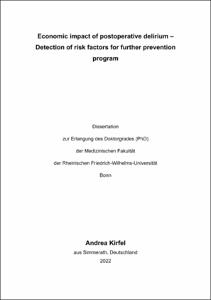Kirfel, Andrea: Economic impact of postoperative delirium – Detection of risk factors for further prevention program. - Bonn, 2022. - Dissertation, Rheinische Friedrich-Wilhelms-Universität Bonn.
Online-Ausgabe in bonndoc: https://nbn-resolving.org/urn:nbn:de:hbz:5-68061
Online-Ausgabe in bonndoc: https://nbn-resolving.org/urn:nbn:de:hbz:5-68061
@phdthesis{handle:20.500.11811/10277,
urn: https://nbn-resolving.org/urn:nbn:de:hbz:5-68061,
author = {{Andrea Kirfel}},
title = {Economic impact of postoperative delirium – Detection of risk factors for further prevention program},
school = {Rheinische Friedrich-Wilhelms-Universität Bonn},
year = 2022,
month = sep,
note = {Introduction: Postoperative delirium (POD) is an underdiagnosed and adverse complication in older adults. The aim of the PRe-Operative Prediction of postoperative DElirium by appropriate Screening (PROPDESC) study was to develop a pragmatic screening risk score for POD. Furthermore, the medico economic outcome was examined in the additional subgroup analysis.
Methods: The prospective observational monocentric study enrolled 1097 patients from Sept. 2018 to Oct. 2019 in the University Hospital Bonn. Inclusion criteria were patient aged 60 years and older and a planned surgery duration of at least 60 minutes. The primary endpoint POD was considered positive if any of the following tests were positive on any of the five postoperative visit days: Confusion Assessment Method for ICU (CAM-ICU), CAM, 4'A's Test (4AT) and Delirium Observation Scale (DOS). The development and validation of the score is based on data-driven approaches to model generation, a boosting process. Multiple logistic regression model was performed for multivariate analysis.
Results: The selected and simplified PROPDESC score with an AUC of 0.725 includes the following variables: age, ASA and NYHA classification, surgical risk as well as ´serial subtraction´ and ´sentence repetition´ of the Montreal Cognitive Assessment. The results of the logistic regression for patients aged 70 years and older showed POD as an independent predictor for a prolonged length of stay (LOS) in Intensive Care Unit (ICU) (36 %; 95 % CI 4–78 %; < 0.001) and in hospital (22 %; 95 % CI 4–43 %; < 0.001). Furthermore, in the cardiac surgery subgroup, the number of POD patients testing positive differed substantially from the coded POD diagnoses in Hospital and the Germany-wide average.
Conclusion: POD showed an independent effect on LOS in ICU and hospital and, moreover, it is highly underdiagnosed in clinical routine. The PROPDESC score, which can be collected in a short time, has good predictive accuracy regardless of surgical discipline.},
url = {https://hdl.handle.net/20.500.11811/10277}
}
urn: https://nbn-resolving.org/urn:nbn:de:hbz:5-68061,
author = {{Andrea Kirfel}},
title = {Economic impact of postoperative delirium – Detection of risk factors for further prevention program},
school = {Rheinische Friedrich-Wilhelms-Universität Bonn},
year = 2022,
month = sep,
note = {Introduction: Postoperative delirium (POD) is an underdiagnosed and adverse complication in older adults. The aim of the PRe-Operative Prediction of postoperative DElirium by appropriate Screening (PROPDESC) study was to develop a pragmatic screening risk score for POD. Furthermore, the medico economic outcome was examined in the additional subgroup analysis.
Methods: The prospective observational monocentric study enrolled 1097 patients from Sept. 2018 to Oct. 2019 in the University Hospital Bonn. Inclusion criteria were patient aged 60 years and older and a planned surgery duration of at least 60 minutes. The primary endpoint POD was considered positive if any of the following tests were positive on any of the five postoperative visit days: Confusion Assessment Method for ICU (CAM-ICU), CAM, 4'A's Test (4AT) and Delirium Observation Scale (DOS). The development and validation of the score is based on data-driven approaches to model generation, a boosting process. Multiple logistic regression model was performed for multivariate analysis.
Results: The selected and simplified PROPDESC score with an AUC of 0.725 includes the following variables: age, ASA and NYHA classification, surgical risk as well as ´serial subtraction´ and ´sentence repetition´ of the Montreal Cognitive Assessment. The results of the logistic regression for patients aged 70 years and older showed POD as an independent predictor for a prolonged length of stay (LOS) in Intensive Care Unit (ICU) (36 %; 95 % CI 4–78 %; < 0.001) and in hospital (22 %; 95 % CI 4–43 %; < 0.001). Furthermore, in the cardiac surgery subgroup, the number of POD patients testing positive differed substantially from the coded POD diagnoses in Hospital and the Germany-wide average.
Conclusion: POD showed an independent effect on LOS in ICU and hospital and, moreover, it is highly underdiagnosed in clinical routine. The PROPDESC score, which can be collected in a short time, has good predictive accuracy regardless of surgical discipline.},
url = {https://hdl.handle.net/20.500.11811/10277}
}






